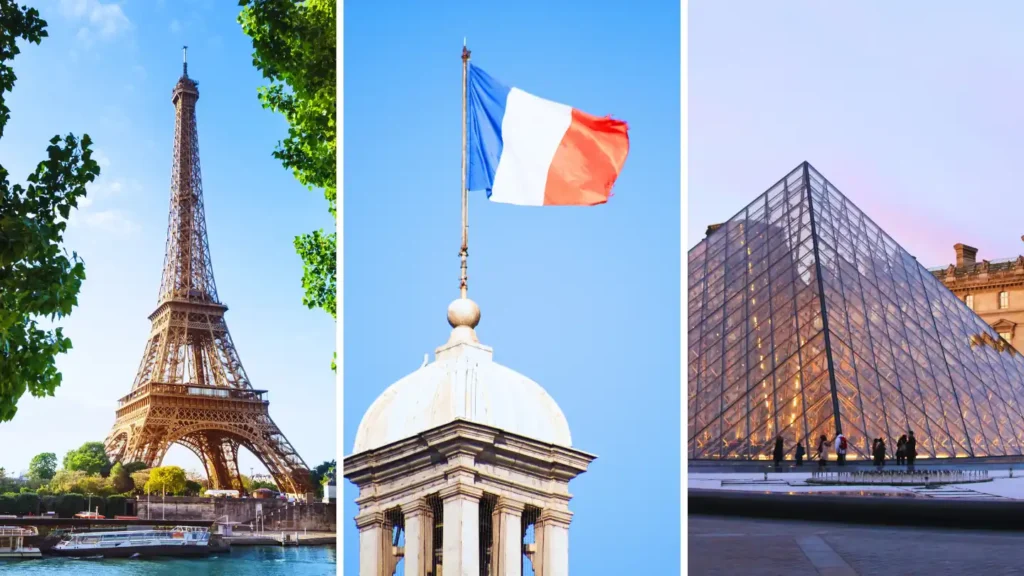So, you’re thinking of France? Excellent choice! It’s one of those places that just has a bit of everything – history, delicious food, incredible art, and landscapes that will make your jaw drop. Planning a France Travel Itinerary can feel a bit overwhelming because there’s so much to see, but trust me, it’s worth every minute of planning.
Let’s explore how to craft an unforgettable journey, whether you’re a first-time visitor or returning for another taste of French magic.
Table of Contents
France Map
First, let’s discuss some general information that applies everywhere in France.
- Currency: The official currency is the Euro (€). Credit cards are widely accepted, but it’s always a good idea to have some cash on hand for smaller purchases, local markets, or tipping.
- Language: French is the official language. While many people in tourist areas, especially younger generations, speak English, knowing a few basic French phrases (such as “Bonjour” – hello, “Merci” – thank you, “S’il vous plaît” – please, and “Pardon” – excuse me) goes a long way and is always appreciated.
- Transportation: France has an excellent public transport system.
- Trains (SNCF): High-speed trains (TGV) connect major cities quickly and comfortably. Regional trains (TER) are great for shorter distances and exploring smaller towns—book in advance for the best prices on TGVs.
- Buses Are Good for connecting smaller towns where trains don’t go and are often more budget-friendly for longer distances (companies like FlixBus).
- Metro/Tram: Major cities like Paris, Nice, and Lyon have excellent metro and tram networks.
- Car Rental: Highly recommended for exploring rural areas like the Loire Valley, Provence, or Normandy, as it gives you the most flexibility. Remember, they drive on the right side of the road.
- Population (approx.): France has a population of around 68 million. Major cities like Paris are densely populated (around 2.1 million in the city proper), while other regions are much more spread out.
- Tourist Advantages: France offers incredible diversity – from world-class museums and historic landmarks to stunning natural landscapes (mountains, beaches, countryside). The food and wine are legendary, and there’s a strong emphasis on culture, art, and a relaxed way of life. It’s also generally very safe for tourists.
- Tourist Information: Most major cities and towns have dedicated tourist offices (Office de Tourisme) where you can get maps, brochures, and local advice. Look for the “i” symbol.
- Safety Tips: France is generally safe, but, like any popular tourist destination, be aware of pickpockets, especially in crowded areas such as metro stations, major attractions, and markets. Keep your belongings secure, be mindful of your surroundings, and refrain from displaying expensive items. Always carry a copy of your passport, leaving the original in the safe at your accommodation.
Now, let’s dive into the places themselves!
1. Paris: The City of Lights

No French travel itinerary is complete without a stop in Paris. It’s truly magical, full of iconic sights and hidden gems.
- Type of Attraction: World-class museums (art, history), iconic landmarks, charming neighborhoods, gourmet dining, fashion, and romantic atmosphere.
- Best Time to Visit:
- Spring (April-May): Pleasant weather, blooming flowers, fewer crowds than summer.
- Fall (September-October): Crisp air, beautiful autumn colors, and still pleasant weather, accompanied by fewer crowds.
- Summer (June-August): Peak tourist season. Warm weather, long daylight hours, but also the biggest crowds and highest prices.
- How Much it Costs (Estimates per person, per day):
- Budget Traveler: €60-€100 (hostels, picnics, free attractions, public transport)
- Mid-Range: €100-€200 (mid-range hotels, some restaurant meals, paid attractions, public transport/some taxis)
- Luxury: €200+ (boutique hotels, fine dining, private tours, taxis/car services)
- Tourist Advantages: Unparalleled cultural experiences, iconic photo opportunities, incredible food at all price points, and efficient public transport.
- Tourist Information: The Paris Tourist Office has branches throughout the city. Consider a Paris Pass or Museum Pass if you plan to visit many attractions – it can save you money and time.
- Best Part of the Tour: It’s hard to pick just one!
- The Eiffel Tower at Night: Watching it sparkle on the hour after sunset is an unforgettable, truly Parisian moment.
- Wandering Montmartre: Getting lost in its charming, artistic streets, watching painters, and enjoying the views from Sacré-Cœur Basilica.
- A Seine River Cruise: A relaxing way to see many landmarks from a unique perspective, especially at sunset.
- Key Attractions & Costs:
- Eiffel Tower: From €11.30 (stairs to 2nd floor) to €28.30 (elevator to summit) for adults. Book online well in advance!
- Louvre Museum: €17 online, €15 on-site. Free for under 26. Plan at least 3-4 hours—closed Tuesdays.
- Musée d’Orsay: Around €16. Famous for Impressionist art.
- Notre Dame Cathedral: Currently under reconstruction after the fire, but you can admire its exterior.
- Arc de Triomphe: Around €16 for adults to climb to the top.
- Transportation within Paris: Excellent metro system. Tickets can be bought individually or in a “Carnet” of 10 for a discount. Buses and trams are also extensive.
Ads


2. The Loire Valley: Fairytale Castles
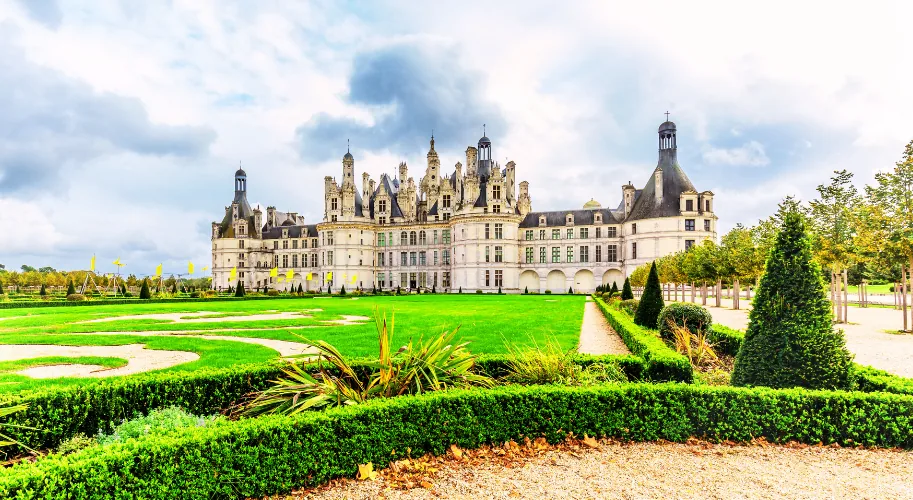
Just a short trip from Paris, the Loire Valley is where you’ll find magnificent châteaux straight out of a storybook. It’s an entirely different vibe – relaxed, lush, and rich in history.
- Type of Attraction: Historical castles, beautiful gardens, vineyards, cycling routes.
- Best Time to Visit:
- Spring (April-June): Gardens are in bloom, the weather is pleasant, and it’s before the peak summer crowds.
- Early Fall (September-October): Harvest season for wine, beautiful foliage, and fewer tourists.
- How Much it Costs (Estimates per person, per day, excluding accommodation):
- Budget/Mid-Range: €50-€100 (train travel, castle entry, picnic lunches, simple dinners).
- Mid-High: €100-€150+ (car rental, multiple castle entries, nicer meals).
- Tourist Advantages: Stunning architecture, a journey back in time, picturesque countryside perfect for cycling or leisurely drives.
- Tourist Information: Local tourist offices in towns like Tours, Blois, and Amboise are excellent resources for maps and advice on visiting the châteaux.
- Best Part of the Tour: Exploring the grand interiors and expansive gardens of the châteaux, feeling like royalty for a day. Renting a bike and cycling between a few closer castles is also a highlight.
- Key Attractions & Costs:
- Château de Chambord: From €19 for adults. It is known for its double-helix staircase (possibly designed by Leonardo da Vinci).
- Château de Chenonceau: From around €17 for adults. Often referred to as “the ladies’ château” due to its rich history of women, it elegantly spans the River Cher.
- Château d’Amboise: Around €15. Connected to Leonardo da Vinci, who lived nearby at Clos Lucé (separate entry, around €18.50).
- Transportation in Loire Valley: While trains connect the main towns (Tours, Blois, Amboise), a rental car is highly recommended to easily reach all the châteaux and explore the countryside at your own pace. Many tour buses also operate from major towns.
3. Provence: Sun, Scent, and Charm
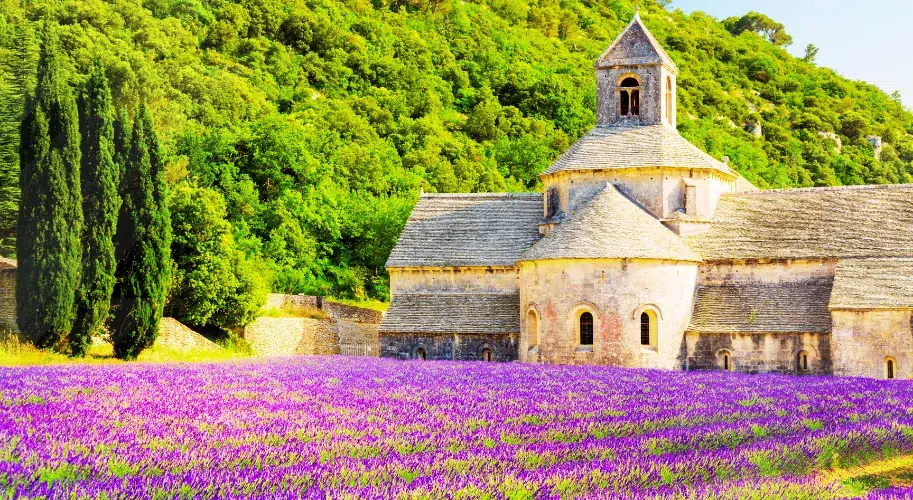
If you dream of vibrant lavender fields, ancient Roman ruins, and charming hilltop villages, Provence is your ideal destination. It’s truly a sensory experience.
- Type of Attraction: Lavender fields (seasonal), Roman history, picturesque villages, vibrant markets, Mediterranean landscapes, and delicious local cuisine.
- Best Time to Visit:
- Late June to mid-July: Best time for lavender fields in bloom (around Valensole, Sault). Expect more tourists.
- Spring (April-May) & Early Fall (September-October): Pleasant weather for exploring villages and cities, fewer crowds, and still beautiful.
- How Much it Costs (Estimates per person, per day, excluding accommodation):
- Budget/Mid-Range: €60-€120 (local bus travel, market food, some restaurant meals, entry to a few sites).
- Mid-High: €120-€200+ (car rental, wider range of dining, more tours/activities).
- Tourist Advantages: Unique natural beauty, ancient history around every corner, delicious Mediterranean-inspired food, and a relaxed pace of life.
- Tourist Information: Tourist offices in major cities, such as Avignon and Aix-en-Provence, are very helpful.
- Best Part of the Tour:
- Lavender Season: Standing amidst the endless purple fields, inhaling the scent – it’s genuinely magical.
- Wandering a Hilltop Village: Places like Gordes or Roussillon, with their winding streets, stone houses, and stunning views.
- Exploring an Outdoor Market: Immersing yourself in the colors, sounds, and smells of fresh produce, cheeses, and local crafts.
- Key Attractions & Costs:
- Palais des Papes (Avignon): Admission costs around €12 for adults—a massive, historic papal palace.
- Pont du Gard: Around €9.50 per vehicle for parking and access to this incredible Roman aqueduct.
- Les Baux-de-Provence: Explore the village (free to wander) and the Carrières de Lumières (an immersive art show, approximately €14.50).
- Transportation in Provence: A rental car is highly recommended for flexibility, especially if you want to chase lavender fields or visit remote villages. Public buses connect some major towns, but for true exploration, a car is the best option.
4. French Riviera (Côte d’Azur): Glamour and Azure Seas
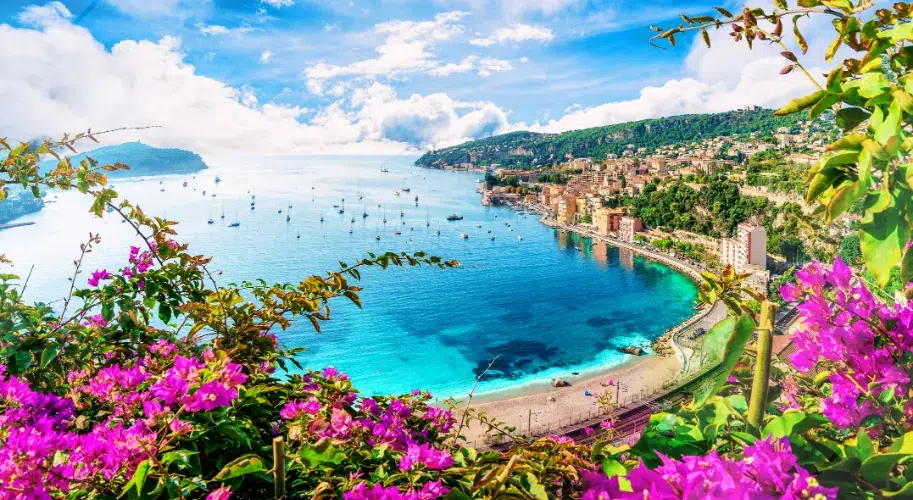
For sunshine, sparkling waters, and a touch of glamour, the French Riviera is a fantastic addition to your France Travel Itinerary.
- Type of Attraction: Beautiful beaches, glamorous towns, charming old towns, art museums, stunning coastal drives.
- Best Time to Visit:
- May-June & September: Warm, sunny weather, pleasant for swimming, but still avoid the absolute peak summer crowds and prices.
- July-August: Hottest months, perfect for beach lovers, but expect huge crowds and high prices.
- How Much it Costs (Estimates per person, per day, excluding accommodation):
- Budget/Mid-Range: €70-€150 (public transport, picnics/casual dining, free beaches).
- Mid-High: €150-€300+ (nicer restaurants, beach clubs, excursions, some taxis/car services). The Riviera can be pricey!
- Tourist Advantages: Consistent sunshine, beautiful beaches (pebbly in Nice, sandy elsewhere), diverse towns from glitzy to charming, great food.
- Tourist Information: Tourist offices are plentiful in Nice, Cannes, Antibes, and other areas, offering maps and activity suggestions.
- Best Part of the Tour:
- Promenade des Anglais (Nice): A stroll or bike ride along this iconic seaside promenade.
- Exploring Old Town Nice (Vieux Nice): Getting lost in the narrow, colorful streets, discovering markets, and enjoying local food.
- Day Trip to Èze: Visiting this incredible medieval hilltop village with panoramic views of the coastline.
- Key Attractions & Costs:
- Promenade des Anglais (Nice): Free!
- Musée Matisse (Nice): Around €10 (check for combined tickets).
- Villa Ephrussi de Rothschild (Saint-Jean-Cap-Ferrat): Around €17. A stunning villa and gardens.
- Monaco: Day trip from Nice by train (around €4-5 one way). Explore the Casino Square (free to walk around; entrance to gambling rooms has a dress code and a fee), Prince’s, and the Palace.
- Transportation in French Riviera: Excellent regional train network that connects all the coastal towns (Nice, Cannes, Antibes, Monaco, Menton). Buses are also suitable for inner-city travel and reaching some hilltop villages. For ultimate flexibility, a rental car is an option, but parking can be challenging and expensive in some towns.
What to Pack
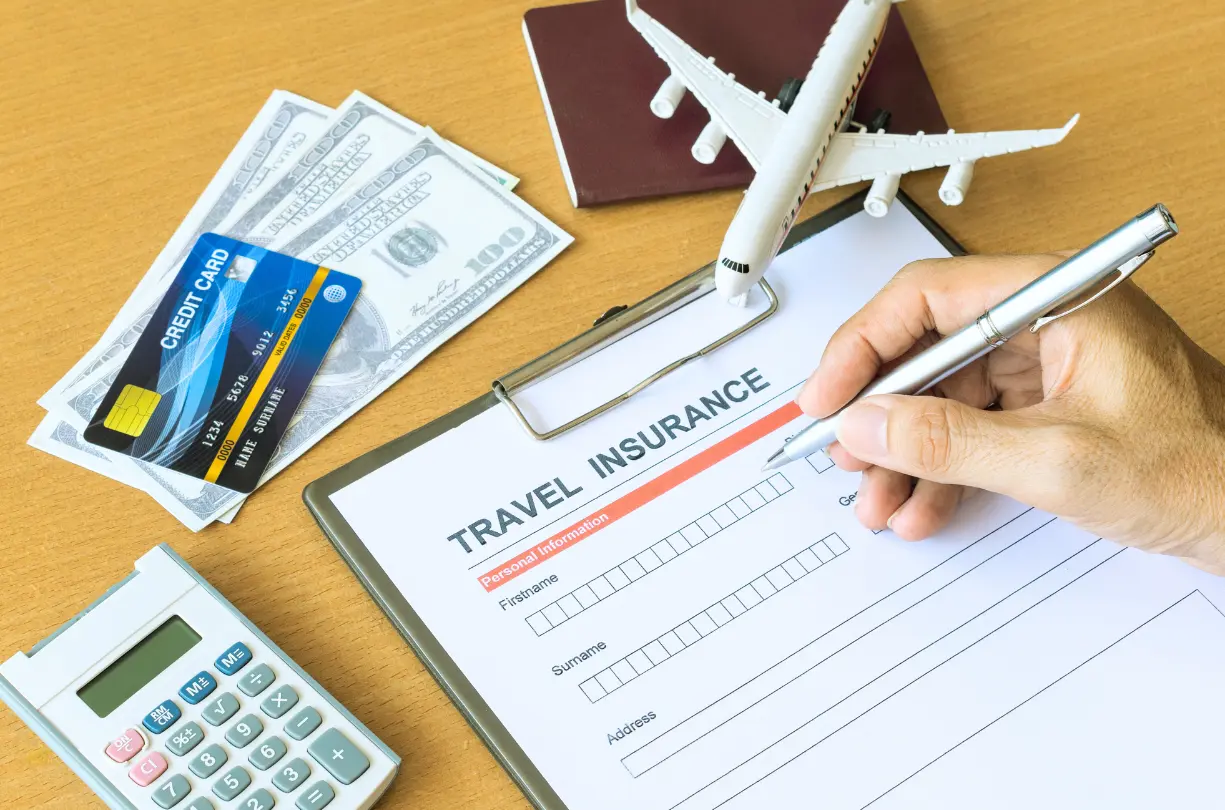
No matter your France Travel Itinerary, here’s a general packing list:
Essentials:
- Passport/Visa: Check requirements for your nationality well in advance.
- Travel Insurance: Always a good idea.
- Universal Travel Adapter: France uses Type E or F plugs (two round pins).
- Power Bank: For keeping your phone charged on the go.
- Copies of Important Documents: Digital and physical copies.
Clothing (Adjust for season):
- Comfortable Walking Shoes: Non-negotiable! You’ll do a lot of walking.
- Layers: T-shirts, long-sleeve tops, a sweater or cardigan, and a light jacket (even in summer for evenings).
- Rain Jacket/Small Umbrella: Ideal for spring and fall.
- Dressier Outfit: For nice dinners or cultural events.
- Swimsuit: If visiting coastal areas or in summer.
Toiletries & Health:
- Personal toiletries (often smaller selections in hotels).
- Any prescription medications, accompanied by a doctor’s note if necessary.
- Basic first-aid (band-aids, pain relievers, antiseptic wipes).
- Sunscreen & Hat (especially for summer or South of France)
Other Useful Items:
- Reusable Water Bottle: Stay hydrated and reduce plastic waste.
- Small Backpack/Day Bag: For daily excursions.
- Scarf: Versatile for warmth, style, or covering shoulders in churches.
- Phrasebook/Translation App: Helpful for basic communication.
- Unlocked Phone: Compatible with a local SIM card, allowing you to use one if desired.
- Tourist SIM Card: Companies like Orange, SFR, and Bouygues Telecom offer prepaid options. eSIMs (like Holafly) are also convenient for easy data access.
Where to Stay
- Hotels: Range from budget-friendly chains to luxurious boutique hotels. Booking in advance, especially in peak season, is crucial. Use sites like Booking.com and Hotels.com, or book directly through the hotel’s website for the best rates.
- Apartments (Airbnb, Vrbo): Ideal for more extended stays, families, or those who prefer self-catering. You get a feel for local life.
- Boutique hotels often offer unique charm and personalized service, typically found in renovated historic buildings.
- Gîtes & Chambres d’hôtes (B&Bs): Especially popular in rural areas like the Loire Valley or Provence. Gîtes are self-catering cottages, while Chambres d’hôtes are charming bed-and-breakfasts, often run by locals, offering a more intimate experience.
- Hostels: A budget-friendly choice, particularly for solo travelers, found in major cities.
This detailed guide should provide a fantastic starting point for planning your perfect French travel itinerary. Enjoy every moment of your adventure!
Frequently Asked Questions
Q: What’s the best time to visit France?
A: Spring (April-May) and Fall (September-October) offer pleasant weather and fewer crowds. Summer (June-August) is a popular but hectic time.
Q: Is English widely spoken in France?
A: In major tourist areas, many people speak English. However, knowing a few basic French phrases (like “Bonjour” and “Merci”) is always appreciated.
Q: What currency is used in France?
A: The official currency is the Euro (€). Credit cards are widely accepted, but cash is helpful for smaller purchases.
Q: How much does a trip to France cost?
A: Costs vary greatly. A budget traveler might spend €60-€100 per day, while a mid-range trip could cost € 100- € 200 or more, excluding accommodation.
Q: What’s the best way to get around France?
A: France has an excellent train system (SNCF). For rural areas like the Loire Valley or Provence, renting a car offers the most flexibility. Major cities have reliable public transportation, including metros and buses.
Q: Do I need a visa to visit France?
A: Visa requirements depend on your nationality. Many countries have visa-free access for short stays (e.g., Schengen Area). Always check official government websites for the latest requirements.
Q: What are the must-see attractions in Paris?
A: Key attractions include the Eiffel Tower, Louvre Museum, Notre Dame (exterior view currently), Montmartre & Sacré-Cœur, and a Seine River cruise.
Q: Is France safe for tourists?
A: Generally, yes. Be aware of pickpockets in crowded tourist areas, just as you would in any major destination, and always keep your belongings secure.
Q: What kind of plug adapter do I need for France?
A: You’ll need a Type E or Type F plug adapter (two round pins).
Q: Can I drink tap water in France?
A: Yes, tap water in France is generally safe and suitable for drinking.

